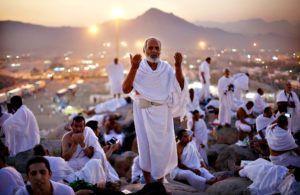(CLEVELAND, OHIO, 1/28/2004) – Thousands of American Muslims will soon take part in religious observances associated with the annual Hajj, or pilgrimage to Mecca. Hajj is one of the “five pillars” of the Islamic faith. (The other pillars include a declaration of faith, daily prayers, offering regular charity, and fasting during the month of Ramadan.)
Pilgrimage is a once-in-a-lifetime obligation for those who have the physical and financial ability to undertake the journey. When the main portion of the pilgrimage is completed, Muslims worldwide gather for communal prayers on the first day (February 1*) of Eid ul-Adha (EED-al-ODD-ha), the second of the two major Muslim holidays. Many Muslims in the Greater Cleveland Area will gather for a city-wide Eid prayer service on Sunday morning at 8:30 am at the Metro Campus of Cuyahoga Community College.
“Participating in the Hajj, perhaps the world’s most ethnically and racially diverse religious event, is a high point of any Muslim’s life,” said Nihad Awad, executive director of the Council on American-Islamic Relations (CAIR), a Washington-based Islamic civil rights and advocacy group. To the Chairman of the newly opened Cleveland Office of CAIR, “Hajj is an annual spiritual journey that Muslims from all over the globe undertake to glorify one God, asking for forgiveness and mercy.”
The obligatory and optional activities of Hajj include:
* Entrance into a state of self-control called ihram, during which pilgrims are forbidden to harm living creatures, even insects or plants, or raise the voice in anger. The state of ihram is signified (for men) by the wearing of two pieces of unsewn white cloth. This clothing signifies the equality of all before God. No specific clothing is prescribed for female pilgrims.
* Circling of the Ka’aba (Tawaf), the stone building Muslims believe was originally built by Abraham and his son Ishmael. The Ka’aba is viewed as the first sanctuary on earth dedicated to the worship of the One God. It is a symbol of unity for Muslims because all prayers, wherever they are performed, are oriented in the direction of the Ka’aba.
* The Sa’i, or “hastening” between two small hills near the Ka’aba, to commemorate Hagar’s search for water to offer her son Ishmael.
* The “Day of Arafah” on January 31.* Arafah is a mountain and its surrounding empty plain near Mecca. On this day, the climax of the Hajj season, pilgrims assemble for supplication to God.
* The stoning of three pillars representing Satan’s temptation of Abraham. The stoning indicates the pilgrim’s rejection of evil deeds.
* Cutting the hair to symbolize the completion of Hajj.
* Sacrifice of an animal to help the poor, and in remembrance of Abraham’s willingness to sacrifice his son Ishmael at God’s command. The meat is distributed to relatives and to the needy.
CAIR, America’s largest Islamic civil liberties group, is headquartered in Washington, D.C., and has 25 regional offices and chapters nationwide and in Canada. CAIR offices in Ohio are located in Columbus, Cincinnati, and Cleveland.
(* Because the beginning of Islamic lunar months depends on the actual sighting of the new moon, the start date for Hajj and Eid ul-Adha may vary.)
– END –
CONTACT: M. Isam Zaiem, 216.830.2247, E-Mail: events@cleveland.cair.com; Julia A. Shearson, 216.830.2247 or 216.440.2247, E-Mail: jshearson@cair.com

